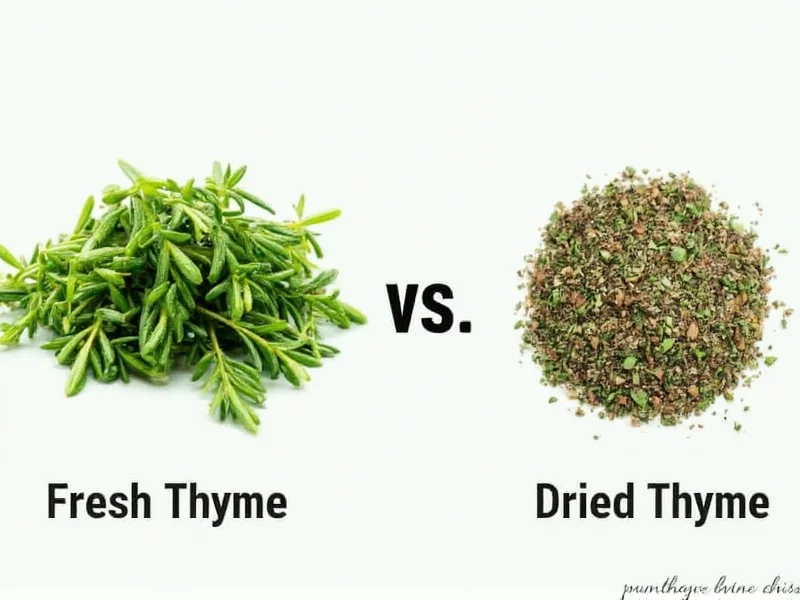Understanding how to properly convert fresh thyme to dried thyme is essential for consistent results in your cooking. Many home chefs struggle with this conversion, leading to dishes that are either under-seasoned or overwhelmingly herbal. The 3:1 ratio exists because drying removes moisture while concentrating the essential oils and flavor compounds that give thyme its distinctive taste.
Why Fresh and Dried Thyme Aren't Interchangeable 1:1
When herbs dry, they lose approximately 75-85% of their weight in water content. For thyme specifically, this dehydration process intensifies the flavor compounds. Fresh thyme has a brighter, more delicate flavor profile with subtle citrus notes, while dried thyme develops a more concentrated, earthy character. This fundamental difference in flavor concentration is why you can't simply swap equal amounts when converting fresh thyme to dried thyme in recipes.
Complete Fresh to Dried Thyme Conversion Chart
| Fresh Thyme | Dried Thyme Equivalent |
|---|---|
| 1 teaspoon fresh | ⅓ teaspoon dried |
| 1 tablespoon fresh | 1 teaspoon dried |
| ¼ cup fresh | 1¼ tablespoons dried |
| ½ cup fresh | 2½ tablespoons dried |
| 1 cup fresh | 5 tablespoons dried (⅓ cup) |
Practical Substitution Tips for Cooking
When converting fresh thyme to dried thyme in your recipes, consider these practical tips for best results:
- Add dried thyme earlier: Dried herbs need time to rehydrate and release their flavors, so add them at the beginning of cooking rather than at the end like fresh herbs
- Adjust to taste: The 3:1 ratio is a starting point—always taste and adjust as your personal preference and the specific dish may require slight modifications
- Consider the dish type: For delicate dishes like fish or eggs, use slightly less dried thyme (try a 4:1 ratio) to prevent overpowering the dish
- Crush dried thyme: Rub dried thyme between your fingers before adding to release more flavor compounds
- Account for age: Older dried thyme loses potency, so you may need to increase the amount slightly if your dried thyme has been stored for more than 6 months
Flavor Profile Differences Between Fresh and Dried Thyme
Understanding the flavor differences helps you make better substitution decisions when converting fresh thyme to dried thyme. Fresh thyme offers:
- A brighter, more floral aroma
- Subtle lemon and mint notes
- A lighter, more delicate flavor that works well in raw applications
- Higher moisture content that affects texture in dishes
Dried thyme provides:
- A more concentrated, earthy flavor profile
- Stronger camphor and pine notes
- Better shelf stability and longer cooking tolerance
- More consistent flavor in long-simmered dishes
When to Use Fresh vs. Dried Thyme
While knowing the conversion ratio for fresh thyme to dried thyme is important, understanding when to use each form will elevate your cooking:
Best uses for fresh thyme:
- Garnishing finished dishes
- Salads and vinaigrettes
- Short-cooking dishes like omelets or sautéed vegetables
- Cocktails and infused beverages
- Dishes where visual appeal matters (fresh sprigs look attractive)
Best uses for dried thyme:
- Long-simmered dishes like stews, soups, and braises
- Dry rubs for meats
- Baked goods like breads and savory pastries
- Sauces that will be strained (dried thyme won't leave leaf fragments)
- When fresh thyme isn't available
Storage Recommendations for Maximum Flavor
Proper storage affects how well your conversion from fresh thyme to dried thyme will work in recipes:
Fresh thyme storage:
- Wrap stems in slightly damp paper towels and store in a plastic bag in the refrigerator
- Alternatively, place stems in a glass with an inch of water (like flowers) and cover loosely with a plastic bag
- Use within 1-2 weeks for best flavor when converting to dried measurements
Dried thyme storage:
- Keep in an airtight container away from light, heat, and moisture
- Store in a cool, dark cupboard (not above the stove)
- Properly stored dried thyme maintains good flavor for 1-2 years
- Test potency by rubbing and smelling—weak aroma means it's time to replace
Common Mistakes When Converting Fresh Thyme to Dried
Avoid these frequent errors when substituting fresh thyme for dried thyme:
- Using equal measurements: This results in dishes that are either too weak or overwhelmingly herbal
- Adding dried thyme too late: Dried herbs need time to rehydrate and release flavors
- Not adjusting for recipe type: Delicate dishes need less dried thyme than robust stews
- Using old dried thyme without adjusting: Potency decreases over time, requiring slightly more
- Not tasting and adjusting: Always taste after adding herbs and adjust as needed
Special Considerations for Specific Cuisines
When converting fresh thyme to dried thyme, consider these cuisine-specific factors:
- Mediterranean cooking: Traditional recipes often specify fresh thyme; when substituting dried, use the full 3:1 ratio as these dishes typically feature bold flavors
- French cuisine: In bouquet garni or fines herbes, dried thyme works well but use slightly less (2.5:1 ratio) to maintain delicate balance
- American Southern cooking: For dishes like gumbo or pot roast, dried thyme often provides better flavor integration in long-cooked dishes
- Vegetarian and vegan cooking: Dried thyme's concentrated flavor can help compensate for reduced meat-based umami











 浙公网安备
33010002000092号
浙公网安备
33010002000092号 浙B2-20120091-4
浙B2-20120091-4